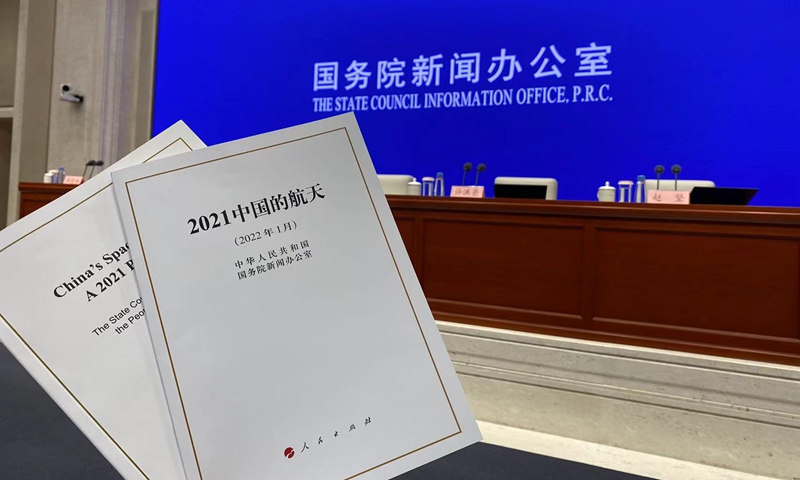
China releases new white paper on space activities Photo:Zhao Juecheng/GT
China released further details surrounding the construction of the International Lunar Research Station (ILRS), saying that the open and inclusive project jointly proposed by China and Russia is expected to become operational by 2035, China National Space Administration (CNSA) deputy head Wu Yanhua told the Global Times on Friday.
"Governments of China and Russia are working closely on the ILRS agreements and have basically reached a consensus, and the agreement will hopefully be signed later this year. After that, a joint declaration on the project will be announced to the world by the national space agencies of the two countries," Wu said.
Wu made the remarks when speaking at a press conference for the release of China's fifth white paper on space activities, officially titled China's Space Program: A 2021 Perspective, commenting on inquiries by the Global Times on the project's status.
At all stages, at all levels of construction, and in terms of sharing of research data and space-ground support system, we have set no limits, and welcome the world to join in its construction, Wu said.
Just like the Antarctic and Arctic research stations, we are inclined to build such a facility at the lunar south pole, and construct a scientific laboratory facility on the moon's surface as well as in lunar orbit, in order to conduct multi-discipline research work.
Wu elaborated that China's phase-4 lunar probe would pursue the goal of constructing a basic form of the ILRS. In five years, China's Chang'e-6 and -7 missions would join force with their Russian counterparts to complete scouting and surveying work before construction begins.
In another 10 years, the construction of the town-like facility would be delivered, which would be equipped with an energy supply system, communication functions, as well as a space-Earth commuting system, among others. "A life supporting system would also be necessary to support human activity in the long run," Wu told the Global Times.
According to Wu, the ILRS will be able to receive visitors from Earth on scientific missions of various countries and organizations, and scientific expeditions on the moon in stages.
With the successful lunar sample retrieving feat of Chang'e-5 in 2020, China has completed the first three phases of the country's lunar probe missions, and initiated research work for the fourth phase in the 13th Five Year Plan period (2016-20), according to Liu Jizhong, director of the China Lunar Exploration and Space Engineering Center, who was also present at Friday press conference.
Liu said that China's phase-4 lunar probe would include four missions, the first of which involves Chang'e-4, which has already achieved a successful landing on the dark side of the moon, and there will be three other missions codenamed Chang'e-6, -7, and -8.
Chang'e-6 would carry out lunar sample return tasks, while Chang'e-7 will probe the lunar polar region, especially looking into water distribution on Moon. Those two missions would be launched around 2025, during which the development for the Chang'e-8 mission will start simultaneously, the official said.
China's Chang'e-7 mission also signed an agreement with Russia's Luna-26 mission, and the two would explore the moon together, Liu said.
Chang'e-8's launch, according to Liu, could be expected before 2030, and would involve verifying key technology for the lunar station.
China and Russia welcome international peers to join in the project, Wu stressed.
The white paper on China's space program is the fifth of its kind following those issued in 2000, 2006, 2011 and 2016. The white paper is normally released every five years.




